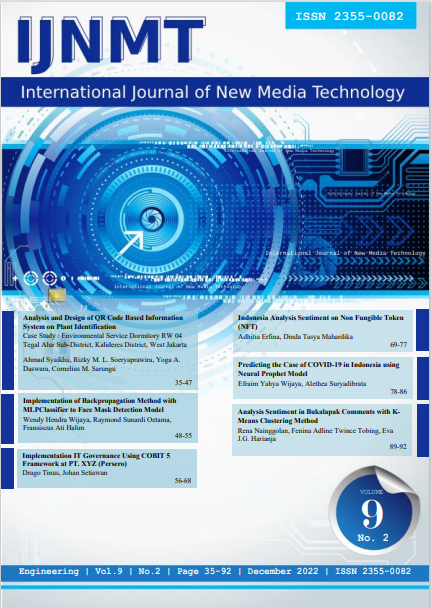Implementation IT Governance Using COBIT 5 Framework at PT. XYZ (Persero)
DOI:
https://doi.org/10.31937/ijnmt.v9i2.2739Abstract
PT. XYZ (Persero) is one of the state-owned companies that move in insurance & guarantee, capital market & investment. PT. XYZ (Persero) conducts an assessment of information technology governance with the aim of meeting the implementation of GCG (Good Corporate Governance) which are listed through KBUMN (Ministry of State-Owned Enterprises) regulations PER-02/MBU/2013 & PER-03/MBU/02 /2018. The regulation PER-02/MBU/2013 has been stipulated on page 6 section 3.2. The target is that "The maturity level target in the next 5 years is a minimum maturity level of 3 in accordance with the specified maturity level”.
PT. XYZ will conduct a COBIT 5 assessment again based on the results of the assessment that has been carried out by the previous assessor. COBIT 5 assessment will be carried out with a target of level 4 so that it is expected to get a maturity value above 3 and can meet the request of KBUMN (Ministry of State-Owned Enterprises).
The assessment is doing by identifying company objectives, mapping Enterprise Goals, mapping IT Related Goals, mapping and determining process domains, analysis the previous assessor's COBIT 5 capability level measurement, measuring the process capability level of EDM01, EDM02 and EDM04, results and gap analysis as well as improvement recommendations.
Based on the assessment that has been carried out on the EDM01, EDM02 & EDM04 process, the final result is obtained with a final value of 97.08% so that it gets a Capability Level of 3,88 and it has a gap of 0,12 from the expected target.
Downloads
Additional Files
Published
How to Cite
Issue
Section
License
Authors retain copyright and grant the journal right of first publication with the work simultaneously licensed under a Creative Commons Attribution-ShareAlike International License (CC-BY-SA 4.0) that allows others to share the work with an acknowledgement of the work's authorship and initial publication in this journal.
Authors are able to enter into separate, additional contractual arrangements for the non-exclusive distribution of the journal's published version of the work (e.g., post it to an institutional repository or publish it in a book), with an acknowledgement of its initial publication in this journal.
Copyright without Restrictions
The journal allows the author(s) to hold the copyright without restrictions and will retain publishing rights without restrictions.
The submitted papers are assumed to contain no proprietary material unprotected by patent or patent application; responsibility for technical content and for protection of proprietary material rests solely with the author(s) and their organizations and is not the responsibility of the IJNMT or its Editorial Staff. The main (first/corresponding) author is responsible for ensuring that the article has been seen and approved by all the other authors. It is the responsibility of the author to obtain all necessary copyright release permissions for the use of any copyrighted materials in the manuscript prior to the submission.















